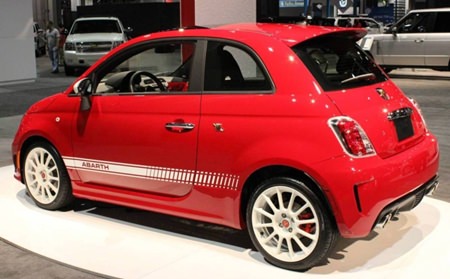What makes a “city car”? Is it something small? Is it something that saves the planet’s oil? Is it something that does not pollute the atmosphere and equally does not blow holes through the ozone layer large enough to sink the Arctic ice cap and a couple of ice-breakers with it? Or is it all of the above?
To be honest, there has been no real consensus on what makes a ‘city car’. Various manufacturers over the years have attempted to produce city cars, most of which have been automotive economic disasters. The Messerschmitt and the BMW Isetta bubble cars of the 50’s and 60’s did nothing for the financial stability of either manufacturer. The world in the hedonistic swinging 60’s was not yet ready for city cars.
 New Fiat 500.
New Fiat 500.
However, by the turn of the new millennium, as the developed world’s cities became more congested, and the doomsayers began announcing the end of the planet’s oil supplies, the public began to rekindle an interest in city cars. Something small might ease the congestion on the roads. A fuel-miser might be cheaper to run as the price of oil goes stratospheric, and a small, but becoming increasingly vocal, group began lobbying for Zero Emission Vehicles (known as ZEVs). A global warning about global warming!
So what is available in the warmer world? Italy may be beset with financial problems, but its auto industry has produced the “must be seen in” city car. It is the Fiat 500 1.3 JTD Pop which returns consumption figures of 4.2 L/100 km. This cute looking retro car is the re-born Fiat 500 of donkey’s years ago, and is the vehicle to be seen in. This car has desirability and efficiency. In fact, official figures place this immensely appealing and quite practical re-born 500 as one of the world’s most fuel efficient autos. And amazingly, it can be found in Thailand, brought in by the ‘grey’ importers. But at a price of around 2 million THB. You will pay heavily at the showroom to be a miser at the pumps.
From Japan comes the Toyota Prius sipping only 4.4 L/100 km and is the world’s most successful automotive marketing exercise (probably to counter its weird styling), but the Prius is synonymous with lean and green motoring.
It is distinctive and that is what counts. What’s the point of making an eco-statement if no one knows you’re making one? It is a bit like wetting yourself in a dark suit. You know what you’ve got, but nobody else does. Prius comes with a premium over standard Toyota models, you will pay around 2 million THB and you are not likely to recoup your investment unless you drive a Porsche Cayenne Turbo and are guzzling fuel at around 19 L/100 km.
Another small car is the German ‘smart’ (no capital letter – another ad agency gimmick), a micro car which has ended up in the Mercedes stable after a troubled birth. With a three cylinder, one liter petrol engine, it is economical and it is small (less than two meters long) and it is expensive. If you do the maths, it is not economically smart to bring in a ‘smart’.
Perhaps we should look at vehicles that are designed primarily as inexpensive vehicles for commuters, so we must look in India, not in Korea or Japan.
The first of these is the Tata Nano, the (almost?) ultimate budget city car, which sells at around 90,000 THB (rupees converted) in India. It is small, so fits the city car concept, and built to a price. You will get one windscreen wiper, not two, manual wind-up windows and an 80 km/h top speed (probably downhill with a good tail wind from the Ganges). If you are currently riding a motorcycle and sidecar, you’ll love it.
However, I do not really see Nanos sputtering around cities in Thailand. We have our eco-cars, the Nissan March, the Mitsubishi Mirage and the Honda Brio, all of which are small and fuel efficient, but have much more performance and abilities than just being a city car.
There must be something better – and there is, and it is electric. More manufacturers are putting money into rechargeable electric cars for the cities. Nissan Renault has its electric Leaf, GM has the Volt, Tesla has the S and BMW has the i-Series. None of them huge sellers in their local market, but much more of a city car.
No, in Thailand there are no real city cars, despite Honda calling one of their models the City. If you are looking for small and economical you will have to wait a little longer!




